Liang An
AniMer+: Unified Pose and Shape Estimation Across Mammalia and Aves via Family-Aware Transformer
Aug 01, 2025Abstract:In the era of foundation models, achieving a unified understanding of different dynamic objects through a single network has the potential to empower stronger spatial intelligence. Moreover, accurate estimation of animal pose and shape across diverse species is essential for quantitative analysis in biological research. However, this topic remains underexplored due to the limited network capacity of previous methods and the scarcity of comprehensive multi-species datasets. To address these limitations, we introduce AniMer+, an extended version of our scalable AniMer framework. In this paper, we focus on a unified approach for reconstructing mammals (mammalia) and birds (aves). A key innovation of AniMer+ is its high-capacity, family-aware Vision Transformer (ViT) incorporating a Mixture-of-Experts (MoE) design. Its architecture partitions network layers into taxa-specific components (for mammalia and aves) and taxa-shared components, enabling efficient learning of both distinct and common anatomical features within a single model. To overcome the critical shortage of 3D training data, especially for birds, we introduce a diffusion-based conditional image generation pipeline. This pipeline produces two large-scale synthetic datasets: CtrlAni3D for quadrupeds and CtrlAVES3D for birds. To note, CtrlAVES3D is the first large-scale, 3D-annotated dataset for birds, which is crucial for resolving single-view depth ambiguities. Trained on an aggregated collection of 41.3k mammalian and 12.4k avian images (combining real and synthetic data), our method demonstrates superior performance over existing approaches across a wide range of benchmarks, including the challenging out-of-domain Animal Kingdom dataset. Ablation studies confirm the effectiveness of both our novel network architecture and the generated synthetic datasets in enhancing real-world application performance.
SemanticSplat: Feed-Forward 3D Scene Understanding with Language-Aware Gaussian Fields
Jun 11, 2025Abstract:Holistic 3D scene understanding, which jointly models geometry, appearance, and semantics, is crucial for applications like augmented reality and robotic interaction. Existing feed-forward 3D scene understanding methods (e.g., LSM) are limited to extracting language-based semantics from scenes, failing to achieve holistic scene comprehension. Additionally, they suffer from low-quality geometry reconstruction and noisy artifacts. In contrast, per-scene optimization methods rely on dense input views, which reduces practicality and increases complexity during deployment. In this paper, we propose SemanticSplat, a feed-forward semantic-aware 3D reconstruction method, which unifies 3D Gaussians with latent semantic attributes for joint geometry-appearance-semantics modeling. To predict the semantic anisotropic Gaussians, SemanticSplat fuses diverse feature fields (e.g., LSeg, SAM) with a cost volume representation that stores cross-view feature similarities, enhancing coherent and accurate scene comprehension. Leveraging a two-stage distillation framework, SemanticSplat reconstructs a holistic multi-modal semantic feature field from sparse-view images. Experiments demonstrate the effectiveness of our method for 3D scene understanding tasks like promptable and open-vocabulary segmentation. Video results are available at https://semanticsplat.github.io.
AniMer: Animal Pose and Shape Estimation Using Family Aware Transformer
Dec 01, 2024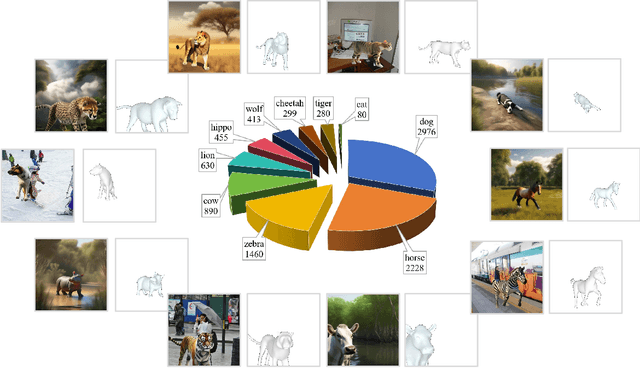



Abstract:Quantitative analysis of animal behavior and biomechanics requires accurate animal pose and shape estimation across species, and is important for animal welfare and biological research. However, the small network capacity of previous methods and limited multi-species dataset leave this problem underexplored. To this end, this paper presents AniMer to estimate animal pose and shape using family aware Transformer, enhancing the reconstruction accuracy of diverse quadrupedal families. A key insight of AniMer is its integration of a high-capacity Transformer-based backbone and an animal family supervised contrastive learning scheme, unifying the discriminative understanding of various quadrupedal shapes within a single framework. For effective training, we aggregate most available open-sourced quadrupedal datasets, either with 3D or 2D labels. To improve the diversity of 3D labeled data, we introduce CtrlAni3D, a novel large-scale synthetic dataset created through a new diffusion-based conditional image generation pipeline. CtrlAni3D consists of about 10k images with pixel-aligned SMAL labels. In total, we obtain 41.3k annotated images for training and validation. Consequently, the combination of a family aware Transformer network and an expansive dataset enables AniMer to outperform existing methods not only on 3D datasets like Animal3D and CtrlAni3D, but also on out-of-distribution Animal Kingdom dataset. Ablation studies further demonstrate the effectiveness of our network design and CtrlAni3D in enhancing the performance of AniMer for in-the-wild applications. The project page of AniMer is https://luoxue-star.github.io/AniMer_project_page/.
ManiDext: Hand-Object Manipulation Synthesis via Continuous Correspondence Embeddings and Residual-Guided Diffusion
Sep 14, 2024Abstract:Dynamic and dexterous manipulation of objects presents a complex challenge, requiring the synchronization of hand motions with the trajectories of objects to achieve seamless and physically plausible interactions. In this work, we introduce ManiDext, a unified hierarchical diffusion-based framework for generating hand manipulation and grasp poses based on 3D object trajectories. Our key insight is that accurately modeling the contact correspondences between objects and hands during interactions is crucial. Therefore, we propose a continuous correspondence embedding representation that specifies detailed hand correspondences at the vertex level between the object and the hand. This embedding is optimized directly on the hand mesh in a self-supervised manner, with the distance between embeddings reflecting the geodesic distance. Our framework first generates contact maps and correspondence embeddings on the object's surface. Based on these fine-grained correspondences, we introduce a novel approach that integrates the iterative refinement process into the diffusion process during the second stage of hand pose generation. At each step of the denoising process, we incorporate the current hand pose residual as a refinement target into the network, guiding the network to correct inaccurate hand poses. Introducing residuals into each denoising step inherently aligns with traditional optimization process, effectively merging generation and refinement into a single unified framework. Extensive experiments demonstrate that our approach can generate physically plausible and highly realistic motions for various tasks, including single and bimanual hand grasping as well as manipulating both rigid and articulated objects. Code will be available for research purposes.
Delving Deep into Pixel Alignment Feature for Accurate Multi-view Human Mesh Recovery
Jan 15, 2023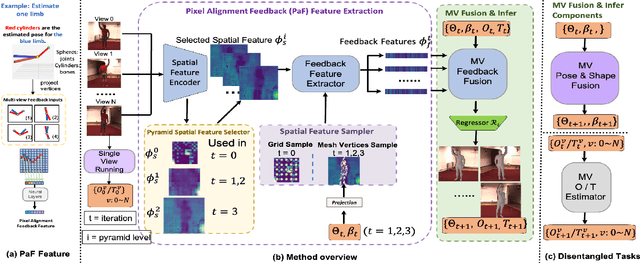

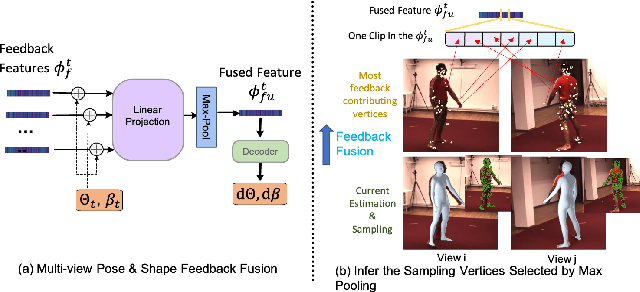

Abstract:Regression-based methods have shown high efficiency and effectiveness for multi-view human mesh recovery. The key components of a typical regressor lie in the feature extraction of input views and the fusion of multi-view features. In this paper, we present Pixel-aligned Feedback Fusion (PaFF) for accurate yet efficient human mesh recovery from multi-view images. PaFF is an iterative regression framework that performs feature extraction and fusion alternately. At each iteration, PaFF extracts pixel-aligned feedback features from each input view according to the reprojection of the current estimation and fuses them together with respect to each vertex of the downsampled mesh. In this way, our regressor can not only perceive the misalignment status of each view from the feedback features but also correct the mesh parameters more effectively based on the feature fusion on mesh vertices. Additionally, our regressor disentangles the global orientation and translation of the body mesh from the estimation of mesh parameters such that the camera parameters of input views can be better utilized in the regression process. The efficacy of our method is validated in the Human3.6M dataset via comprehensive ablation experiments, where PaFF achieves 33.02 MPJPE and brings significant improvements over the previous best solutions by more than 29%. The project page with code and video results can be found at https://kairobo.github.io/PaFF/.
PyMAF-X: Towards Well-aligned Full-body Model Regression from Monocular Images
Jul 18, 2022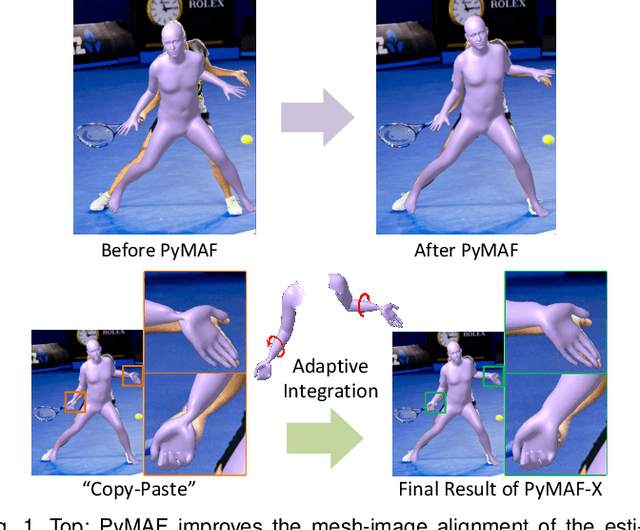
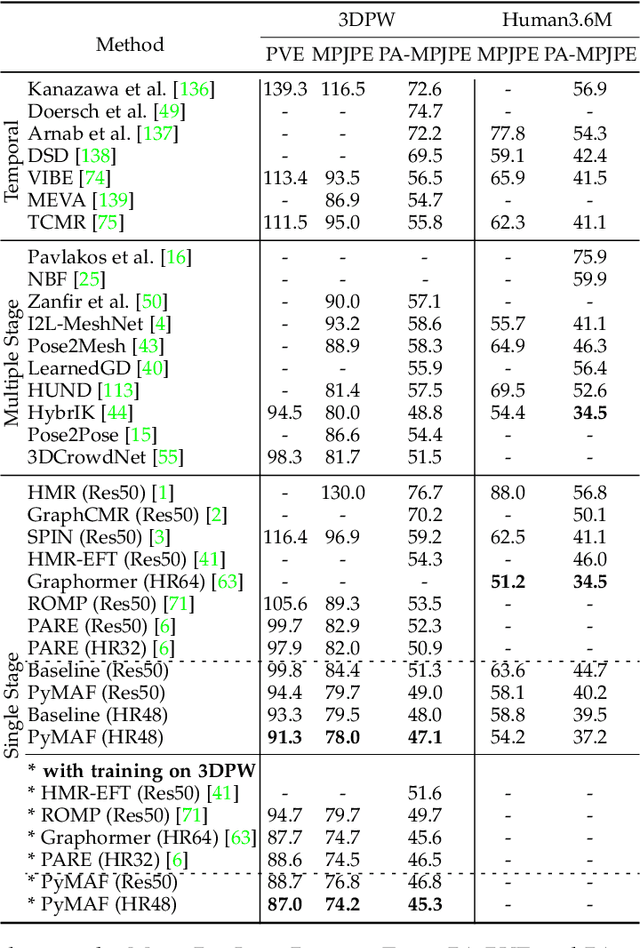
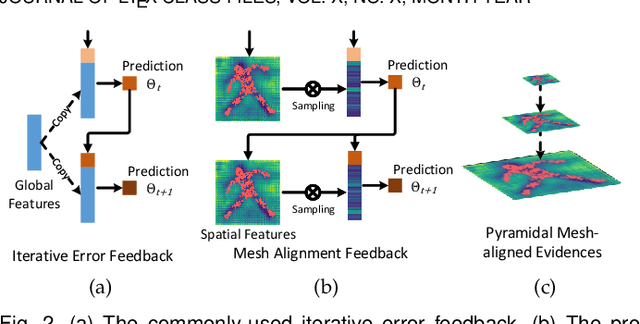
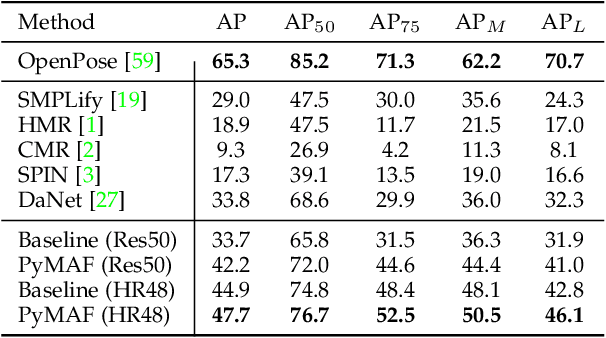
Abstract:We present PyMAF-X, a regression-based approach to recovering a full-body parametric model from a single image. This task is very challenging since minor parametric deviation may lead to noticeable misalignment between the estimated mesh and the input image. Moreover, when integrating part-specific estimations to the full-body model, existing solutions tend to either degrade the alignment or produce unnatural wrist poses. To address these issues, we propose a Pyramidal Mesh Alignment Feedback (PyMAF) loop in our regression network for well-aligned human mesh recovery and extend it as PyMAF-X for the recovery of expressive full-body models. The core idea of PyMAF is to leverage a feature pyramid and rectify the predicted parameters explicitly based on the mesh-image alignment status. Specifically, given the currently predicted parameters, mesh-aligned evidence will be extracted from finer-resolution features accordingly and fed back for parameter rectification. To enhance the alignment perception, an auxiliary dense supervision is employed to provide mesh-image correspondence guidance while spatial alignment attention is introduced to enable the awareness of the global contexts for our network. When extending PyMAF for full-body mesh recovery, an adaptive integration strategy is proposed in PyMAF-X to produce natural wrist poses while maintaining the well-aligned performance of the part-specific estimations. The efficacy of our approach is validated on several benchmark datasets for body-only and full-body mesh recovery, where PyMAF and PyMAF-X effectively improve the mesh-image alignment and achieve new state-of-the-art results. The project page with code and video results can be found at https://www.liuyebin.com/pymaf-x.
Interacting Attention Graph for Single Image Two-Hand Reconstruction
Mar 18, 2022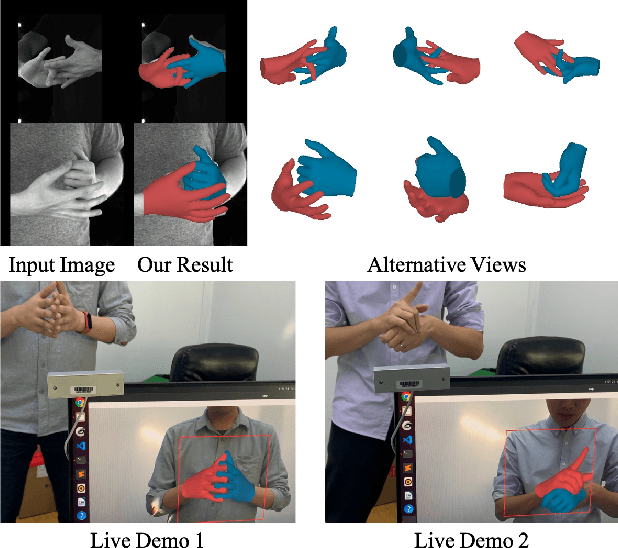
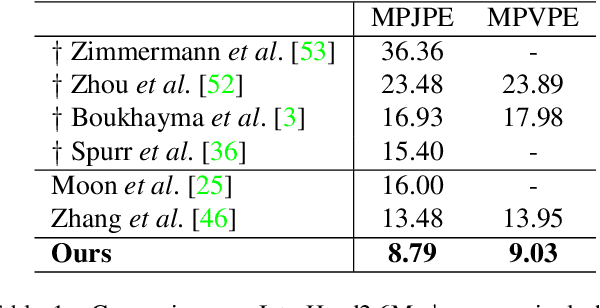
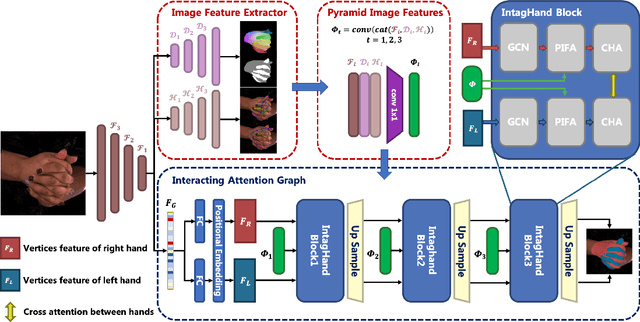
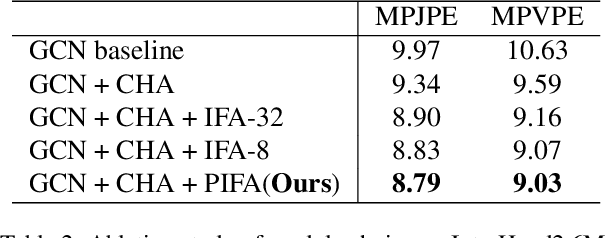
Abstract:Graph convolutional network (GCN) has achieved great success in single hand reconstruction task, while interacting two-hand reconstruction by GCN remains unexplored. In this paper, we present Interacting Attention Graph Hand (IntagHand), the first graph convolution based network that reconstructs two interacting hands from a single RGB image. To solve occlusion and interaction challenges of two-hand reconstruction, we introduce two novel attention based modules in each upsampling step of the original GCN. The first module is the pyramid image feature attention (PIFA) module, which utilizes multiresolution features to implicitly obtain vertex-to-image alignment. The second module is the cross hand attention (CHA) module that encodes the coherence of interacting hands by building dense cross-attention between two hand vertices. As a result, our model outperforms all existing two-hand reconstruction methods by a large margin on InterHand2.6M benchmark. Moreover, ablation studies verify the effectiveness of both PIFA and CHA modules for improving the reconstruction accuracy. Results on in-the-wild images and live video streams further demonstrate the generalization ability of our network. Our code is available at https://github.com/Dw1010/IntagHand.
Lightweight Multi-person Total Motion Capture Using Sparse Multi-view Cameras
Aug 23, 2021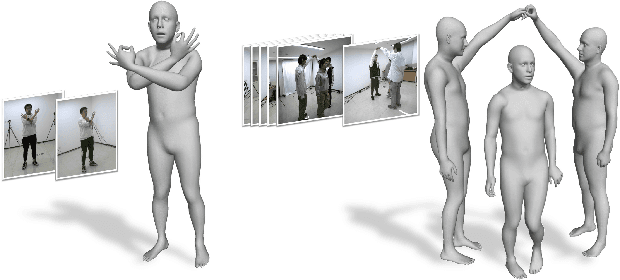


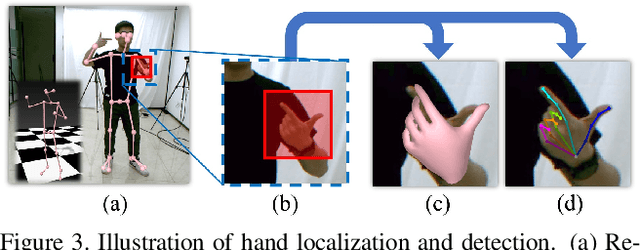
Abstract:Multi-person total motion capture is extremely challenging when it comes to handle severe occlusions, different reconstruction granularities from body to face and hands, drastically changing observation scales and fast body movements. To overcome these challenges above, we contribute a lightweight total motion capture system for multi-person interactive scenarios using only sparse multi-view cameras. By contributing a novel hand and face bootstrapping algorithm, our method is capable of efficient localization and accurate association of the hands and faces even on severe occluded occasions. We leverage both pose regression and keypoints detection methods and further propose a unified two-stage parametric fitting method for achieving pixel-aligned accuracy. Moreover, for extremely self-occluded poses and close interactions, a novel feedback mechanism is proposed to propagate the pixel-aligned reconstructions into the next frame for more accurate association. Overall, we propose the first light-weight total capture system and achieves fast, robust and accurate multi-person total motion capture performance. The results and experiments show that our method achieves more accurate results than existing methods under sparse-view setups.
4D Association Graph for Realtime Multi-person Motion Capture Using Multiple Video Cameras
Feb 28, 2020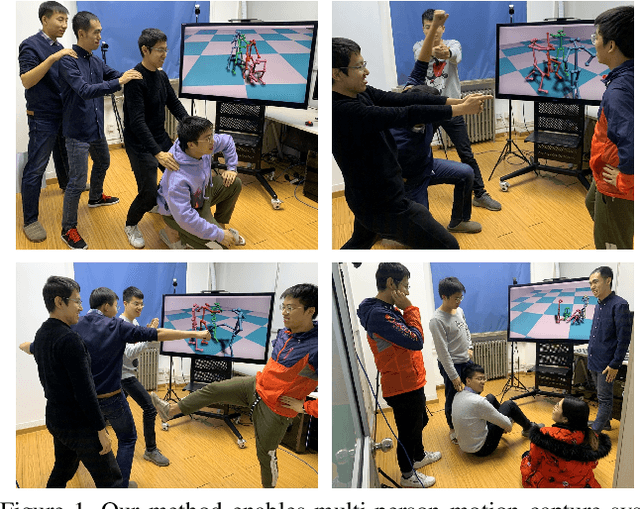
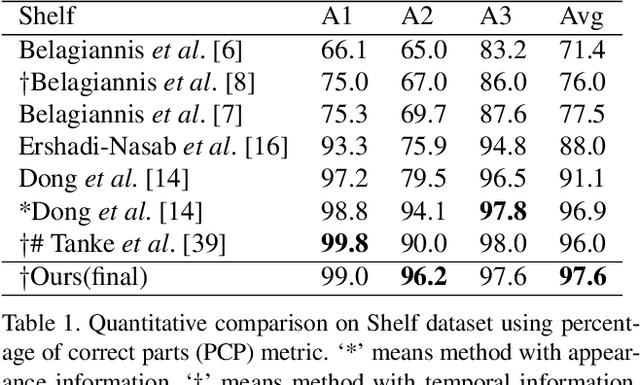


Abstract:This paper contributes a novel realtime multi-person motion capture algorithm using multiview video inputs. Due to the heavy occlusions in each view, joint optimization on the multiview images and multiple temporal frames is indispensable, which brings up the essential challenge of realtime efficiency. To this end, for the first time, we unify per-view parsing, cross-view matching, and temporal tracking into a single optimization framework, i.e., a 4D association graph that each dimension (image space, viewpoint and time) can be treated equally and simultaneously. To solve the 4D association graph efficiently, we further contribute the idea of 4D limb bundle parsing based on heuristic searching, followed with limb bundle assembling by proposing a bundle Kruskal's algorithm. Our method enables a realtime online motion capture system running at 30fps using 5 cameras on a 5-person scene. Benefiting from the unified parsing, matching and tracking constraints, our method is robust to noisy detection, and achieves high-quality online pose reconstruction quality. The proposed method outperforms the state-of-the-art method quantitatively without using high-level appearance information. We also contribute a multiview video dataset synchronized with a marker-based motion capture system for scientific evaluation.
 Add to Chrome
Add to Chrome Add to Firefox
Add to Firefox Add to Edge
Add to Edge